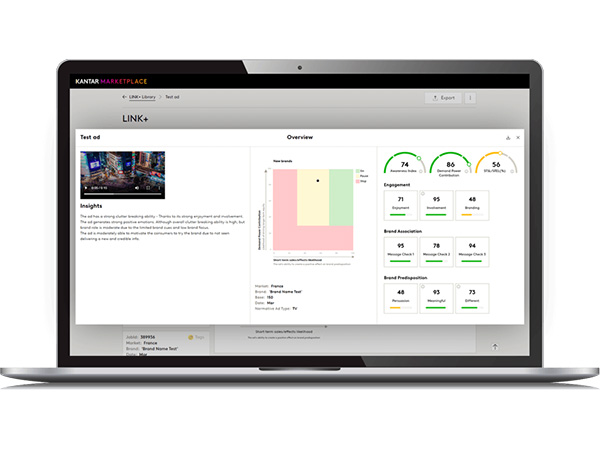This doesn’t mean that marketers can afford to procrastinate. Digital audio is already an increasingly indispensable part of marketers’ toolkits. Nearly half of marketers (43%) globally are planning to increase their investment in major digital audio platform Spotify in 2025. And it’s not only specific brands that benefit. Those who plan to increase their investment in podcasts add up to 41%, and music streaming is not far behind at 37%. Podcasts are the most well-received online ad platform by consumers, who seem them as trustworthy and relevant ads. On the other hand, music streaming as an advertising channel needs a bit of a boost in its reputation. Some consumers see the ads as intrusive and repetitive.
Effectiveness of audio ads
Although the industry is swiftly adopting the channel, the big question for marketers remains: Do audio ads work? Just like any other channel, audio ads can drive brand uplifts if they are executed well and are fit for purpose. Currently, Kantar’s Context Lab effectiveness norms point to a modest performance per exposure, showing up slightly below the overall digital average for main brand KPIs. However, this points to a lack of understanding of how these “new” ad types should work, rather than an intrinsic fault with the channel itself. Online audio advertising is still a growing craft. Marketers are experimenting with formats from straight radio-style spots to creative host integrations. Not all advertisers have found the formula for highly engaging audio creative yet, and many audio ads today are repurposed from radio or other media, which does not fully leverage the digital audio context. Podcast ads for example, being often longer and content-integrated, might achieve different results than 30-second radio spots. This means that testing ads and building best practices is key to improve ad performance and brand lift.Creative performance of audio ads
It’s not all doom and gloom – there are certainly audio ads and campaigns that perform exceptionally well. In a meta-analysis of 10 ads tested in the UK – each as a traditional radio ad and a digital audio ad - we’ve unearthed some interesting learnings.
At the overall level, there aren’t major differences between the performance of traditional radio ads and digital audio ads. However, this doesn’t tell us the whole story. Many individual ads perform more strongly in context, such as Ginsters’ “Scarecrow.” The “Scarecrow” ad was tested both as a traditional radio ad and a digital audio ad on Spotify where a static visual was included in the ad experience. The difference in performance was significant. The digital audio ad brought more enjoyment, conveyed the branding better, and persuaded the consumers better among other successes, demonstrating the power of the channel when the ad is executed well.
Ginsters’ “Scarecrow” ad performed distinctly better as a digital audio ad on Spotify than as a traditional radio ad

The role of visual elements in audio streaming
This goes hand in hand with the recent trend of adding visuals – including video – to audio advertising and media in general. One might assume that visuals are irrelevant in an audio-first medium. However, evidence shows that visuals can significantly enhance audio advertising. When asked about their habits, over 50% of streaming audio users said they often look at their screens while listening, and in total roughly 85% at least sometimes check the screen during audio sessions. In other words, most people do engage visually with their devices even as audio plays. It is important to note that they might be engaging with different parts of their screen or different windows while they listen, however the opportunity is clear. 60% of the ads tested in our digital audio meta-analysis performed better accompanied by a picture for the listeners to focus on. Using a visual companion to an audio ad can reinforce the message. However, the critical information should not be left to the visual alone. Similar to how users can miss the audio of video ads on social media feeds, they can miss the visual component of an audio ad.
Why are listeners looking at screens? Often, it’s to interact with the app – e.g., to skip a track, search for a song, or see what’s playing. Sometimes, particularly with podcasts or music videos, users may actively watch the content. Platforms like Spotify have noted this trend and introduced features like looping video clips (Canvas) and even full video podcasts, acknowledging that users’ eyes are on the screen more than one might expect in “audio” mode.
Audio consumption habits: when and how people listen
These results lead to two truths: marketers have to test their digital audio ads to build best practices and tailor to context, and they need to keep on top of the consumer pulse. Learning how people engage with “emerging media” is key. According to our digital audio meta-analysis, most digital audio listening happens at home, contrary to the common assumption that people mainly tune in while driving or commuting. 76% of people said they listen “at home,” surpassing the second place “whilst walking” by 25%.
Majority of people listen to audio streaming at home

When it comes to the types of digital audio that’s most consumed, music is the predominant content heard on streaming platforms, with 85% of users listening. Podcasts have also become hugely popular – about half of streaming users report listening to podcasts. This is a significant figure, indicating that podcasts are now a mainstream audio format alongside music. Podcast talents can now garner hundred million-dollar contracts and reach wide audience across big markets. Alex Cooper’s Call Her Daddy podcast signed to SiriusXM for $125m, is one of the most listened to podcasts in the US, for example. Marketers can no longer view podcasts as niche; they are a major avenue to reach engaged audiences, especially given the intimate, one-on-one feel of podcast contents.
Digital audio’s place in the marketing mix
Online audio is a dynamic and growing media channel that offers both reach and targeted opportunities. According to Kantar’s LIFT+ database, digital audio’s average reach is close to 30%, meaning it provides a great opportunity to create incremental reach for campaigns in its own authentic way. Its strengths lie in the deep engagement of formats like podcasts and the ubiquity of music streaming in consumers’ lives. Audio ads can contribute to brand growth – especially when crafted and deployed with the medium’s unique qualities in mind: personal, conversational, often consumed in parallel with other activities.
For the marketing community, the mandate is clear: include digital audio in the media mix but continue to test and learn. Digital audio is not yet grown up as a channel, and it requires attention and care in order to take full advantage of its capabilities. As marketers learn how to execute, consumers will welcome with less trepidation, and the campaigns will be more impactful in the long run.
To find out more about how we measure digital audio advertising effectiveness and other digital platforms visit Kantar’s Context Lab and Media Effectiveness solutions, or get in touch.



